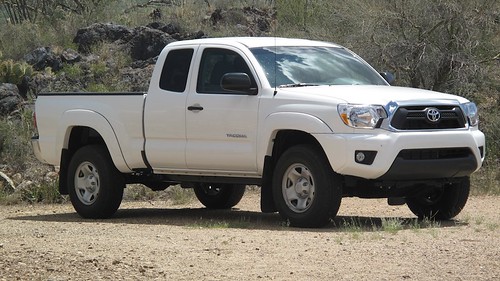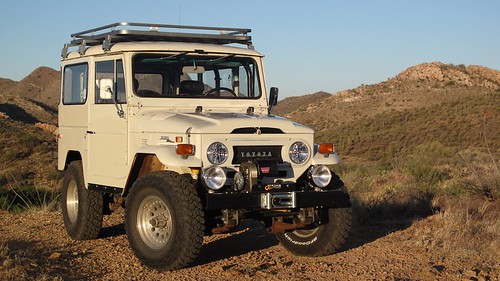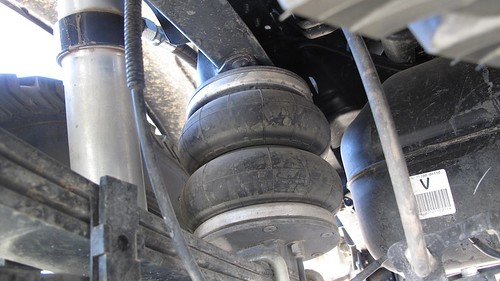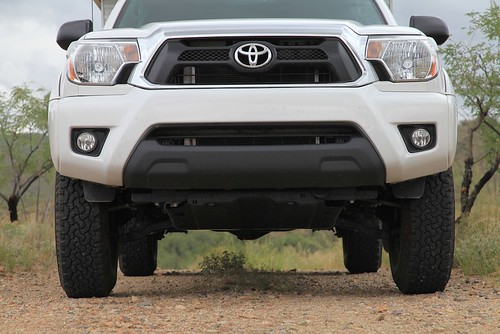 The JATAC with Four Wheel Camper mounted; LT235/85 R16 BFG All-Terrain tires, Boss air bags on stock rear springs, Icon shocks at all four corners.
The JATAC with Four Wheel Camper mounted; LT235/85 R16 BFG All-Terrain tires, Boss air bags on stock rear springs, Icon shocks at all four corners.
At the Overland Expo this May, Roseann gave a walkaround of the JATAC to a crowd of about 40 attendees, and throughout the weekend we were frequently approached by individuals and couples who’d seen it displayed or had read about it here, and who had various questions. Most were of the general general how-do-you-like-the-combination sort; many got into specifics of our modifications. But two questions about what we hadn’t done cropped up with interesting frequency:
- “Why didn’t you install a suspension lift?”
- “Why didn’t you install larger tires?”
The short answer to both questions is, “Physics.” The long answer follows.
Our goal in mating a Toyota Tacoma with a Four Wheel Camper was to strike a balance between reliability, durability, capability, comfort, and convenience. The camper provides comfort and convenience; it’s up to the truck to contribute reliability, durability, and capability. Part of the balance is realizing that roughly 1,000 pounds of comfort and convenience has potentially significant effects on the other three.
Reliability of the Tacoma should be a given. The Identifix rating for the current generation Tacoma shows five stars for every year since 2006. Our 2000 Tacoma was the single most reliable vehicle I have ever owned: In 160,000 miles we did nothing to it except scheduled maintenance. Not one repair. Even my faithful 1973 FJ40 couldn’t match that record at that mileage (burned exhaust valve at 150,000). It’s still too early to pass judgement on the new truck, but statistically we should be able to look forward to a similar experience.
Durability should be a given as well, certainly in terms of the drivetrain. Engines in general are lasting longer these days (200,000 miles really is the new 100,000), thanks to better materials and more precise machining capabilities—and Toyota engines, transmissions, and differentials stand out even among these higher standards. I’m still not completely sold on the composite bed or the open-channel back half of the chassis, but my master Toyota mechanic friend Bill Lee keeps telling me to stop fretting.
That leaves capability, which is what most people are attempting to augment with suspension lifts and larger tires (unless they’re strictly after the looks).
 The Tacoma as we got it, with stock P245/75R16 all-season tires (30.5" diameter). It’s true that a mild suspension lift will increase chassis ground clearance and—if properly specced for the vehicle—improve suspension travel and compliance, enhancing both ride comfort and the ability of the truck to keep all four wheels on the ground for better traction when traversing rough terrain. Larger-diameter tires also increase ground clearance, and provide a fractionally longer footprint that can enhance traction.
The Tacoma as we got it, with stock P245/75R16 all-season tires (30.5" diameter). It’s true that a mild suspension lift will increase chassis ground clearance and—if properly specced for the vehicle—improve suspension travel and compliance, enhancing both ride comfort and the ability of the truck to keep all four wheels on the ground for better traction when traversing rough terrain. Larger-diameter tires also increase ground clearance, and provide a fractionally longer footprint that can enhance traction.
But there is a price to be paid for those gains. Let’s look at tires first.
A larger tire weighs more than a smaller tire—common sense, obviously, but the range of effects of that weight are not all obvious. As an example, let’s compare a couple of BFG All-Terrains. The LT235/85 R16 ATs we recently installed on the Tacoma are 31.7 inches in diameter, and weigh 46.4 pounds each. If we decided to go up in diameter a very modest 1.5 inches, to a 295/75 R16 AT at 33.2 inches diameter, that tire weighs 57 pounds. That’s ten pounds of unsprung weight (a term that refers to weight not supported by the suspension, including wheels and tires, brake components, bearings, axles, etc.—think of everything that goes up and down under the vehicle when you hit a bump) to gain 3/4-inch of ground clearance. Adding ten pounds to a vehicle’s unsprung weight has a far more dramatic effect on ride and handling than adding the same amount to the sprung mass. The springs and shock absorbers have to react to that weight over every imperfection in the road.
But that’s not the only effect. The mass of a larger tire (and, if fitted, a wider wheel) places additional stress on the braking system and retards acceleration—and the tire’s rotational moment of inertia, which increases with the square of diameter if I’m remembering my physics correctly, affects both as well. A 2003 study of the effects of suspension lifts and larger tires showed that going from a 32-inch tire to a 35-inch tire resulted in a ten percent loss in brake efficiency. That’s a significant effect on your ability to stop quickly.
Finally, a larger-diameter tire affects gearing. For example, at a constant 65 mph, the engine in a vehicle equipped with 4.11 differentials, a 1:1 top gear in the transmission, and 31-inch tires will be turning approximately 2900 rpm. With 33-inch tires the same vehicle will be turning 2720 rpm. That might sound like a good thing—after all, lower engine speeds should equate to better fuel economy, right? Unfortunately, it’s rarely so. You’re messing with a torque curve that the factory knows inside and out, and you can bet they’ve calculated the final drive ratio to optimize that curve. The losses associated with the extra mass and rotational inertia will almost certainly cancel out any possible gains in highway mileage with increased city consumption, as shown by numerous controlled studies.
Going up in tire diameter will also hurt your low-range performance, since the vehicle will be traveling faster at any given engine speed. That will reduce your control in low-speed situations. Few vehicles these days come with low-range transfer-case gears I consider low enough anyway (although the now nearly ubiquitous automatic transmission helps), so compromising what’s there makes little sense.
Why not simply regear the differentials to compensate, as dedicated rock crawlers do when they install those big 40-inch-plus tires? In terms of correcting the overall final drive ratio, it works—but at the expense of differential strength. The problem lies in the pinion gear, the only gear of the two major pieces in the differential one can change in size to alter the gearing (the ring gear is limited by the size of the differential case itself). So when one goes from, say, a 4:1 differential to, say, a 5:1, the pinion gear is essentially reduced in size from one fourth the size of the ring gear to one fifth its size. Additionally, the smaller pinion gear means that fewer teeth will be in contact between the two gears at any one time. And you still face the inescapable physics of accelerating and decelerating a larger, heavier tire. Breaking a diff on a local rock-crawling trail would be a pain. Breaking a diff on the Dempster Highway—or on the Dhakla Escarpment—would be a major pain.
What about suspension lifts? Done correctly (i.e., with properly rated springs and shocks; no eight-inch shackles or lift blocks), and kept within reasonable limits (two to four inches on most vehicles, especially those with independent front suspension), the biggest disadvantage you’re likely to encounter is increased drag and reduced fuel economy. True, your center of gravity will be fractionally higher, but the increased ground clearance for approach, breakover, and departure angles is probably a fair tradeoff. However, on a truck with a cabover camper, overhead clearance becomes an issue. On some of the biological surveys we do in Mexico, trees hang low enough over the approach trails to be a concern even with a stock suspension.
All this might sound like I’m dead set against straying at all from factory suspension heights and tire sizes. Not at all—but doing so does involve compromise, and the further one strays from stock tire sizes and suspension heights, the more compromises involved. As long as you’re aware of the issues, consider the cost/benefit ratio, and don’t go all monster truck, your approach might well be different than ours yet still effective for you. Consider my FJ40, which has both a mild (two-inch) Old Man Emu suspension lift and tires (255/85R16 BFG Mud-Terrains) that are at 33 inches significantly larger than the teeny factory-supplied 29-inch tall Dunlops. I settled on the combination after years of driving the vehicle stock, and with careful consideration of the drivetrain. The FJ40’s rear axle shafts are the same diameter as those in a Dana 60 (which is installed on 3/4-ton pickups), and its ring and pinion gear are nearly as stout—I’m on my original differentials at 320,000 miles. The front Birfield joints are not as bulletproof, but very few FJ40 owners have problems with them unless they’re running 35-inch or taller tires with power steering (my steering is powered by how hard I can turn the wheel). Mechanic-friend Bill once said that if I ever broke a Birfield with my setup he’d drive out and replace it for free. He hasn’t yet had to pay up on that offer. Also, significantly, the 1973 FJ40 came from the factory with drum brakes on all four wheels. I’ve installed discs all around, so my braking system is far superior to the factory setup even with the larger tires.
 With a two-inch OME suspension, 255/85/16 tires are a good fit on the FJ40. Rear tires tuck into fender well without rubbing when springs are fully compressed.
With a two-inch OME suspension, 255/85/16 tires are a good fit on the FJ40. Rear tires tuck into fender well without rubbing when springs are fully compressed.
Given our intended use of the JATAC, which will combine long trips on pavement, extended mileage on dirt roads (we drive seven miles of dirt road just to get home), frequent use on four-wheel-drive trails, but little or no intensive rock crawling/mud surfing unless we find ourselves in a situation that requires it, we elected to stay with a very moderate size increase on the tires (to those 235/85/16 BFG All-Terrains), and stock suspension height. I leveled the back end of the truck with a set of excellent Boss air bags over the stock springs, and the shocks at all four corners are adjustable Icons with remote reservoirs.
 Boss air bags augment the Tacoma's stock springs to maintain a level stance with varying loads.
Boss air bags augment the Tacoma's stock springs to maintain a level stance with varying loads.
We still plan to augment the JATAC’s off-pavement capabilities in other ways. First, we’ll be adding a locker for the rear differential—after tires (maybe even before) the absolute best way to enhance traction in difficult situations. Second, we’re working with Pronghorn Overland Gear on a prototype aluminum winch bumper. Pronghorn has just introduced an extremely high-quality modular bumper system for the Jeep Wrangler; the Tacoma is next on their list, and if the result is as good as the Wrangler version it will be good indeed—improbably light yet strong enough to take the the most demanding stresses of winching without complaint*. The Pronghorn bumper will also be compatible with the Hi-Lift jack already mounted to the Four Wheel Camper (see here). With a winch mounted up front we’ll have a backup plan if our tires and locker (and piloting) can’t get us out of a sticky situation. Finally, Pronghorn will also be developing a full aluminum skid-plate system for the Tacoma, so if our moderate ground clearance proves inadequate now and then, the underside of the truck will be fully protected.
 As with many trucks employing independent front suspension, the lowest spot on the JATAC's undercarriage is the rear differential, visible here beneath the front factory "skid plate." The diff's placement in the center of the axle means it's more likely to drag on high-crowned trails. Larger-diameter tires would increase this clearance fractionally; a suspension lift would not.
As with many trucks employing independent front suspension, the lowest spot on the JATAC's undercarriage is the rear differential, visible here beneath the front factory "skid plate." The diff's placement in the center of the axle means it's more likely to drag on high-crowned trails. Larger-diameter tires would increase this clearance fractionally; a suspension lift would not.
This reminds me: I keep meaning to add a set of MaxTrax as well. We were recently on the Grand Canyon’s North Rim after a heavy rain, and the washes in the House Rock Valley had flowed energetically. The first one we came to had subsided to a trickle, but the substrate was still treacherous. The odds were nearly certain we could have crossed with no trouble, but we were a single vehicle with no winch. A stuck truck could have meant hours of digging out, with more rain and flash floods likely. Additionally, beyond this first wash were several larger ones between us and our goal on the rim. So we turned around. A simple set of MaxTrax (or any of several other suitable brands of sand track) would have given us the confidence to take the slight risk.
The JATAC on its modest tires and stock-height suspension might not have the brawny look of a taller sister truck on meatier tires, but we’re convinced it was the right approach for us and our intended uses. But I’ll be honest—if we change our minds, I’ll let you know.
Boss Global is here. Icon Vehicle Dynamics is here. Pronghorn Overland Gear is here. Maxtrax is here.
*Full disclosure: I consulted with Pronghorn on some final design details and proof of concept of their Wrangler bumper system.
